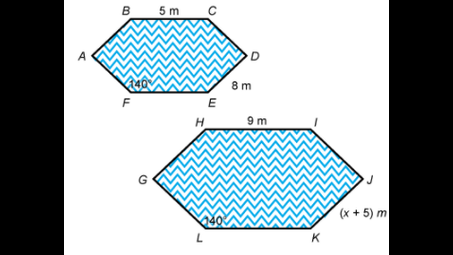what- Two similar hexagonal swimming pools are shown.What is KJ Round to the nearest tenth?
What else can I help you with?
How are hexagonal prisim and pyramids alike?
Hexagonal prisms and hexagonal pyramids are both polyhedra that feature hexagonal bases, which means they each have six sides in their base shape. They share similar geometric properties, including the ability to tessellate in certain arrangements. Additionally, both types of solids can be characterized by their vertical height and their volume can be calculated using base area and height formulas. However, they differ in that a prism has two parallel hexagonal bases, while a pyramid has one hexagonal base and converges to a single apex point.
The surface areas of two similar hexagonal prisms are 882 and1058 What is the scale factor of the smaller prism to the larger prism?
It is 21/23.
How is rounding to the nearest ten similar to rounding to the nearest ten thousand?
They both involve rounding numbers.
How is rounding to nearest tens similar to rounding to the nearest thousand?
The process of rounding is the same no matter what place you're rounding to.
How do you use the rounded the the nearest hundredth formula?
The formula, in Excel and similar spreadsheets, is "=round(number,2)".
What does a hexagonal nut driver do?
It is a tool - similar to a screwdriver only it has a socket on the end
Which aspect of hexagonal writing leads you to consider works that have similar elements?
literary allusions
How are hexagonal prisim and pyramids alike?
Hexagonal prisms and hexagonal pyramids are both polyhedra that feature hexagonal bases, which means they each have six sides in their base shape. They share similar geometric properties, including the ability to tessellate in certain arrangements. Additionally, both types of solids can be characterized by their vertical height and their volume can be calculated using base area and height formulas. However, they differ in that a prism has two parallel hexagonal bases, while a pyramid has one hexagonal base and converges to a single apex point.
What is the difference between a wurtzite structure and a hexagonal structure?
The wurtzite structure is a specific type of hexagonal crystal structure characterized by a tetrahedral coordination of atoms and a specific stacking sequence of atomic layers. While both structures are hexagonally symmetrical and share similar lattice parameters, the wurtzite structure typically has a different arrangement of atoms compared to other hexagonal structures like graphite or hcp (hexagonal close-packed). In summary, all wurtzite structures are hexagonal, but not all hexagonal structures are wurtzite.
How are the atmosphere and oceans similar?
stupid question
What is Allen screwdriver?
Allen screw drivers are similar to Allen keys. This tool is using for tightening or unfascinating hexagonal socket head screws.
The surface areas of two similar hexagonal prisms are 882 and1058 What is the scale factor of the smaller prism to the larger prism?
It is 21/23.
How is the water in the swimming pool similar to earth's interior?
Pressure inside Earth increases much like pressure in the swimming pool increases.
How is rounding to the nearest ten similar to rounding to the nearest ten thousand?
They both involve rounding numbers.
Can algae in a swimming pool cause ringworm?
No, but it could cause similar appearing skin irritations.
What aspect of hexagonal writing leads you to consider works that have similar elements?
Hexagonal writing emphasizes the interconnectedness of ideas and themes by allowing writers to explore multiple perspectives within a single framework. This approach encourages the identification of patterns and relationships, making it easier to draw parallels with other works that feature similar narrative structures, themes, or character dynamics. The visual and structural representation of concepts in hexagonal writing also facilitates comparisons across different texts, highlighting shared motifs or styles. Ultimately, this method fosters a deeper understanding of how diverse works resonate with one another.
How is rounding to nearest tens similar to rounding to the nearest thousand?
The process of rounding is the same no matter what place you're rounding to.

